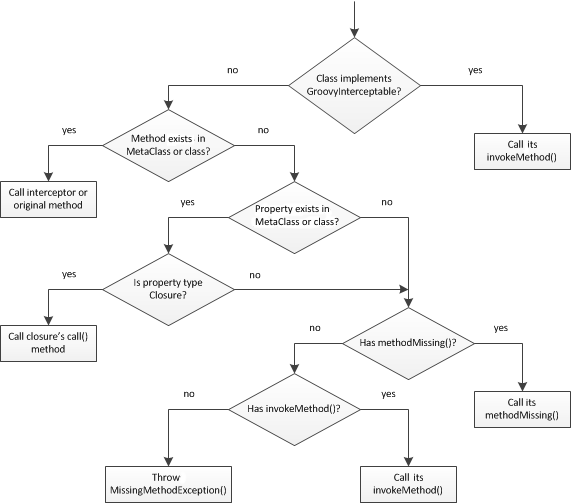Reference: https://en.wikipedia.org/wiki/Metaclass
Reference: https://docs.groovy-lang.org/latest/html/api/groovy/lang/Category.html
Reference: https://groovy-lang.org/metaprogramming.html
Reference: https://groovy-lang.org/metaprogramming.html#categories
Reference: https://groovy-lang.org/metaprogramming.html#xform-Category
Reference: https://docs.groovy-lang.org/next/html/documentation/#_differences_with_mixins
Reference: https://docs.groovy-lang.org/latest/html/api/groovy/lang/ExpandoMetaClass.html
Reference: https://www.youtube.com/watch?v=UJhlp5P7Ec0
- goals of this workshop:
- introducing the concept of runtime metaprogramming
- introducing the concept of category (plus simple example)
- introducing the concept of mixin (plus simple example)
- exercises are in
workshoppackage, answers inanswers
- allows altering the class model and the behavior of a program at runtime
- JVM supports very dynamic behaviour (much cannot be easily used by Java)
All problems in computer science can be solved by another level of indirection
David Wheeler
- this level of indirection is
MetaClassandGroovyObject(object compiled with groovy compiler) - for every method invocation from groovy code, Groovy will find the
MetaClassfor the given object and delegate the method resolution to the metaclass- https://docs.groovy-lang.org/latest/html/api/groovy/lang/MetaClass.html
- should not be confused with
GroovyObjectwhich happens to be a methods that the metaclass may eventually call (MetaClass#invokeMethodvsGroovyObject#invokeMethod)
- should not be confused with
- https://docs.groovy-lang.org/latest/html/api/org/codehaus/groovy/runtime/DefaultGroovyMethods.html
'123'.reverse() is '321' // investigate that invocations: reverse() and is public static String reverse(CharSequence self) { return new StringBuilder(self).reverse().toString(); } public static boolean is(Object self, Object other) { return self == other; } - https://docs.groovy-lang.org/latest/html/api/groovy/lang/MetaClass.html
MetaClass,MetaClassImpldefines the behaviour of any given Groovy or Java class// Goal = to be able to simply write "1.m + 20.cm - 8.mm" Number.metaClass { getMm = { delegate } getCm = { delegate * 10.mm } getM = { delegate * 100.cm } } assert (1.m + 20.cm - 8.mm) == 1.192.m- simple analogy: just as an ordinary class defines the behavior of certain objects, a metaclass defines the behavior of certain classes and their instances
- all method/property calls from Groovy code go through the meta class
getProperty(Class sender, Object receiver, String property, boolean isCallToSuper, boolean fromInsideClass)invokeMethod(Class sender, Object receiver, String methodName, Object[] arguments, boolean isCallToSuper, boolean fromInsideClass)
ExpandoMetaClass extends MetaClassImpl implements GroovyObjectExpandoMetaClassis aMetaClassthat behaves like anExpando- it allows for dynamically adding or changing methods, constructors, properties and even static methods by using a neat closure syntax
- In Groovy we work with three kinds of objects
- POJO - a regular Java object
- POGO - a Groovy object whose class is written in Groovy
- extends
java.lang.Object - implements
groovy.lang.GroovyObject - through
GroovyObjectwe have access toMetaClass
- extends
- Groovy Interceptor - a Groovy object
- implements
groovy.lang.GroovyInterceptable- is marker interface that extends
GroovyObjectand is used to notify the Groovy runtime that all methods should be intercepted through the method dispatcher mechanism of the Groovy runtime
- is marker interface that extends
- has method-interception capability
Live Demo class Example { static void main(String[] args) { X x = new X(); x.id = 1; println x.id // 1 x.go(); // called invokeMethod go() } } class X implements GroovyInterceptable { protected dynamicProps = [:] @Override void setProperty(String name, val) { dynamicProps[name] = val } @Override def getProperty(String name) { dynamicProps[name] } @Override def invokeMethod(String name, Object args) { return "called invokeMethod $name($args)" } }
- implements
- simple example
class Student { List schedule = [] def addLecture(String lecture) { schedule << lecture } } class Worker { List schedule = [] def addMeeting(String meeting) { schedule << meeting } } class CollegeStudent { // note that it's better to use `Traits` than to hack multiple inheritance in that way static { mixin Student, Worker } } new CollegeStudent().with { addMeeting('Performance review with Boss') addLecture('Learn about Groovy Mixins') println schedule // [Performance review with Boss] println mixedIn[Student].schedule // [Learn about Groovy Mixins] println mixedIn[Worker].schedule // [Performance review with Boss] } - it is useful when the class is not under our control
- in order to enable this capability, Groovy implements a feature called
mixin - let you add a
mixinon any type at runtime - the instances are not modified
- if you
mixinsome class into another, there isn’t a third class generated - methods which respond to
Awill continue responding toAeven ifmixedin
- if you
- simple example
class Distance { def number String toString() { "${number}m" } } @Category(Number) class NumberCategory { Distance getMeters() { new Distance(number: this) } } use (NumberCategory) { assert 42.meters.toString() == '42m' } - it is useful when the class is not under our control
- in order to enable this capability, Groovy implements a feature called
Categories - internals:
- during compilation, all methods are transformed to static ones with an additional self parameter
- properties invoked using
thisreferences are transformed so that they are instead invoked on the additional self parameter and not on the Category instance
@CategoryAST transformation simplifies the creation of Groovy categories- Historically, a Groovy category was written like this:
class TripleCategory { public static Integer triple(Integer self) { 3*self } } use (TripleCategory) { assert 9 == 3.triple() } @Categorytransformation lets you write the same using an instance-style class, rather than a static class style@Category(Integer) class TripleCategory { public Integer triple() { 3*this } } use (TripleCategory) { assert 9 == 3.triple() }
- Historically, a Groovy category was written like this:
